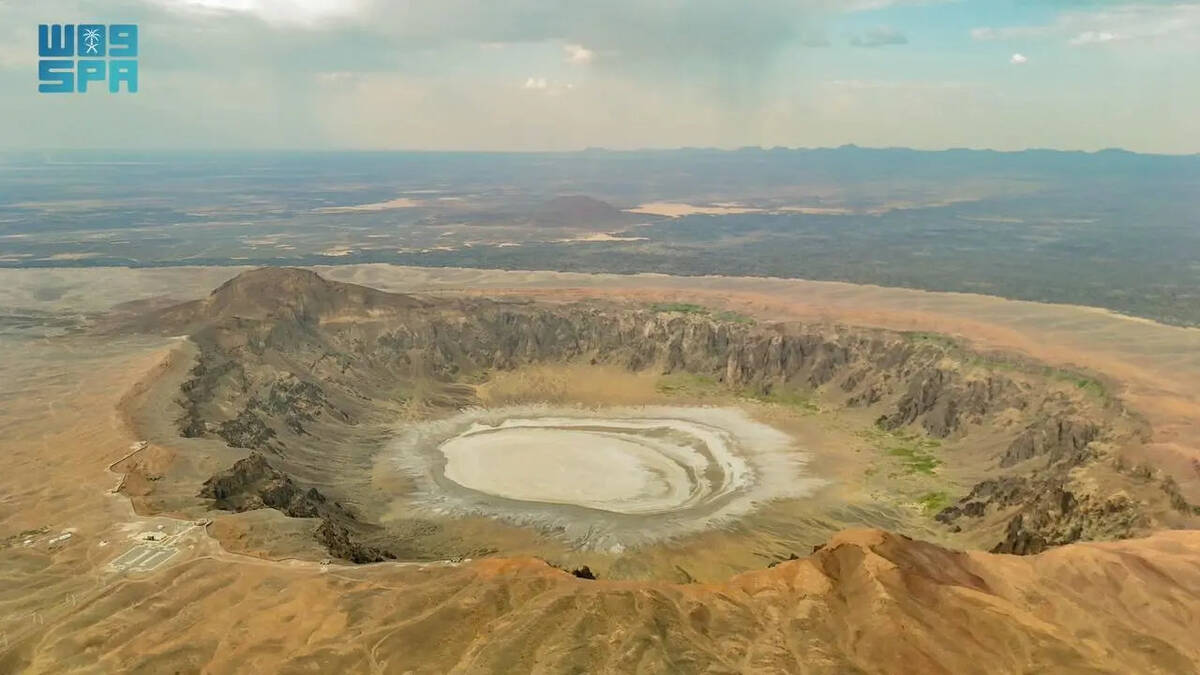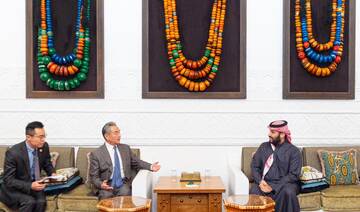JEDDAH: Scattered across Saudi Arabia’s vast deserts and mountains lie more than 2,500 volcanic craters — relics of a fiery geological past that continues to intrigue scientists and thrill adventurous travellers today.
These ancient volcanoes have not erupted in centuries. Their silence, however, belies their significance.

“The Kingdom possesses one of the largest volcanic fields (locally known as Al-Harrat) in the world,” Turki Essam Al-Sehli, senior director of the Geohazard Center at the Saudi Geological Survey, told Arab News.
“These fields cover an area of approximately 90,000 square kilometers — around 4.6 percent of the Kingdom’s total area.”
The last known eruption was in 1256 AD, when lava from Al-Harrat Rahat flowed within 20 kilometers of Madinah. While dramatic in its time, such activity has long since ceased. “The Kingdom has experienced relative volcanic stability for centuries,” Al-Sehli said.

One of Saudi Arabia's largest lava fields is Harrat Rahat, which stretches from northern Makkah to Madinah. (SPA photo)
This dormancy, combined with the dramatic scenery of ancient lava fields, has opened the door to a growing trend: volcano tourism.
From stark black cones to craters that plunge deep into the Earth, Saudi Arabia’s volcanic landscape offers some of the most breathtaking geological sights in the region.
Among the most striking is Al-Wahbah, a vast crater near Taif that is 250 meters deep and more than two kilometers across. In the Asir region, Jabal Farwa — the Kingdom’s tallest volcanic peak — rises more than 3,000 m above sea level.

A view of Al-Wahbah crater near Taif. From stark black cones to craters that plunge deep into the Earth, Saudi Arabia’s volcanic landscape offers some of the most breathtaking geological sights in the region. (SPA photo)
Meanwhile, the Khaybar tract is home to Mount Al-Qadar, where lava once flowed for more than 50 km, and the otherworldly Mount Al-Abyad, known for its pale color and unusual formations.
“Fields like Rahat and Khaybar are characterized by hundreds of volcanic cones formed by mild explosive eruptions and vast lava flow areas reaching lava flow length over 50 km on some occasions, which grant them significant geological and scientific importance,” Al-Sehli said.
“Additionally, they are considered the largest in the Arab world and the Middle East.”
DID YOU KNOW?
• The last volcanic eruption in the Hijaz region occurred in 1256 AD, southeast of Madinah.
• Its lava flow extended for 23 kilometers, stopping 8.2 km short of the Prophet’s Mosque.
• Saudi Arabia’s volcanic landscape has the potential to become a global tourist destination.
While some fields are still classified as “potentially active,” experts agree there is no cause for alarm.
“Some volcanic fields are categorized as potentially active due to the geophysical indicators of eruptible magma in the mid-crust, which means there is a possibility — even if slight — of future volcanic activity,” Al-Sehli said.
“Currently, there are no signs of imminent danger.”

Combo image from the Saudi Geological Survey showing a remote seismic station, which are equipped with satellite telemetry, sensors to convert seismic wave velocities into digital signals, and device to convert the analog electrical signals into digital signals. (SGS photos)
Indeed, any future eruption, while highly unlikely in the short term, would be closely monitored. The Saudi Geological Survey operates a state-of-the-art seismic and volcanic surveillance network designed to detect even the slightest changes beneath the surface.
Should a large eruption take place, however, the environmental impact and the effect on the local climate could be significant.
“In the event of a major volcanic eruption, the emission of fine volcanic ash and gases such as sulfur dioxide, carbon dioxide and other greenhouse gases into the upper layers of the atmosphere could lead to temporary cooling of the local or regional climate, as well as generating acid rainfall,” Al-Sehli said.
Opinion
This section contains relevant reference points, placed in (Opinion field)
With little risk posed by these sleeping giants and great natural beauty to explore and enjoy, Saudi Arabia is increasingly investing in geotourism — promoting its volcanic fields not as hazards, but as heritage.
“There is growing interest in developing geological tourism in the Kingdom,” Al-Sehli said. “The ministry of tourism is collaborating with the Saudi Geological Survey to develop and preserve these geological sites.”
The Saudi Geological Survey’s role extends far beyond monitoring. It produces maps and reports, conducts scientific research, and works to raise public awareness through exhibitions and outreach programs.

Among the SGS other functions include the identification of potential hazards such as landslides, earthquakes and desertification. (SGS)
It also helps identify and conserve key geological sites, ensuring that Saudi Arabia’s volcanic past is protected for future generations.
From lava trails to towering cones, the Kingdom’s volcanic fields offer a window into Earth’s ancient forces — and a unique travel experience for those looking to explore a different side of Saudi Arabia.
These volcanoes may be dormant, but their potential — for knowledge, for tourism, and for wonder — is anything but.



















